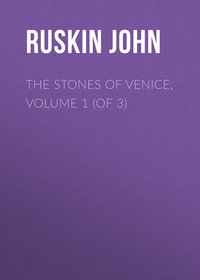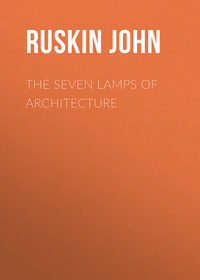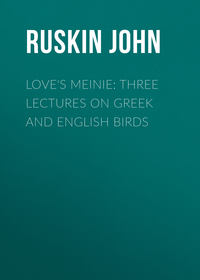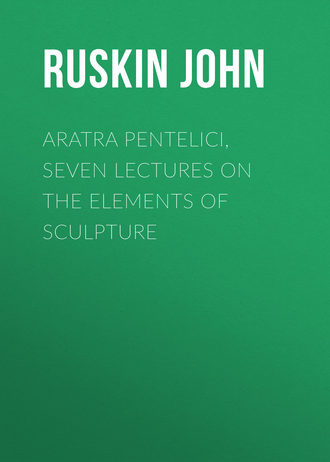 полная версия
полная версияAratra Pentelici, Seven Lectures on the Elements of Sculpture

John Ruskin
Aratra Pentelici, Seven Lectures on the Elements of Sculpture / Given before the University of Oxford in Michaelmas Term, 1870
PREFACE
1. I must pray the readers of the following Lectures to remember that the duty at present laid on me at Oxford is of an exceptionally complex character. Directly, it is to awaken the interest of my pupils in a study which they have hitherto found unattractive, and imagined to be useless; but more imperatively, it is to define the principles by which the study itself should be guided; and to vindicate their security against the doubts with which frequent discussion has lately incumbered a subject which all think themselves competent to discuss. The possibility of such vindication is, of course, implied in the original consent of the Universities to the establishment of Art Professorships. Nothing can be made an element of education of which it is impossible to determine whether it is ill done or well; and the clear assertion that there is a canon law in formative Art is, at this time, a more important function of each University than the instruction of its younger members in any branch of practical skill. It matters comparatively little whether few or many of our students learn to draw; but it matters much that all who learn should be taught with accuracy. And the number who may be justifiably advised to give any part of the time they spend at college to the study of painting or sculpture ought to depend, and finally must depend, on their being certified that painting and sculpture, no less than language, or than reasoning, have grammar and method,—that they permit a recognizable distinction between scholarship and ignorance, and enforce a constant distinction between Right and Wrong.
2. This opening course of Lectures on Sculpture is therefore restricted to the statement, not only of first principles, but of those which were illustrated by the practice of one school, and by that practice in its simplest branch, the analysis of which could be certified by easily accessible examples, and aided by the indisputable evidence of photography.1
The exclusion of the terminal Lecture2 of the course from the series now published, is in order to mark more definitely this limitation of my subject; but in other respects the Lectures have been amplified in arranging them for the press, and the portions of them trusted at the time to extempore delivery (not through indolence, but because explanations of detail are always most intelligible when most familiar) have been in substance to the best of my power set down, and in what I said too imperfectly, completed.
3. In one essential particular I have felt it necessary to write what I would not have spoken. I had intended to make no reference, in my University Lectures, to existing schools of Art, except in cases where it might be necessary to point out some undervalued excellence. The objects specified in the eleventh paragraph of my inaugural Lecture3 might, I hoped, have been accomplished without reference to any works deserving of blame; but the Exhibition of the Royal Academy in the present year showed me a necessity of departing from my original intention. The task of impartial criticism4 is now, unhappily, no longer to rescue modest skill from neglect; but to withstand the errors of insolent genius, and abate the influence of plausible mediocrity.
The Exhibition of 1871 was very notable in this important particular, that it embraced some representation of the modern schools of nearly every country in Europe: and I am well assured that, looking back upon it after the excitement of that singular interest has passed away, every thoughtful judge of Art will confirm my assertion, that it contained not a single picture of accomplished merit; while it contained many that were disgraceful to Art, and some that were disgraceful to humanity.
4. It becomes, under such circumstances, my inevitable duty to speak of the existing conditions of Art with plainness enough to guard the youths whose judgments I am intrusted to form, from being misled, either by their own naturally vivid interest in what represents, however unworthily, the scenes and persons of their own day, or by the cunningly devised, and, without doubt, powerful allurements of Art which has long since confessed itself to have no other object than to allure. I have, therefore, added to the second of these Lectures such illustration of the motives and course of modern industry as naturally arose out of its subject; and shall continue in future to make similar applications; rarely indeed, permitting myself, in the Lectures actually read before the University, to introduce, subjects of instant, and therefore too exciting, interest; but completing the addresses which I prepare for publication in these, and in any other, particulars, which may render them more widely serviceable.
5. The present course of Lectures will be followed, if I am able to fulfill the design of them, by one of a like elementary character on Architecture; and that by a third series on Christian Sculpture: but, in the meantime, my effort is to direct the attention of the resident students to Natural History, and to the higher branches of ideal Landscape: and it will be, I trust, accepted as sufficient reason for the delay which has occurred in preparing the following sheets for the press, that I have not only been interrupted by a dangerous illness, but engaged, in what remained to me of the summer, in an endeavor to deduce, from the overwhelming complexity of modern classification in the Natural Sciences, some forms capable of easier reference by Art students, to whom the anatomy of brutal and floral nature is often no less important than that of the human body.
The preparation of examples for manual practice, and the arrangement of standards for reference, both in Painting and Sculpture, had to be carried on, meanwhile, as I was able. For what has already been done, the reader is referred to the "Catalogue of the Educational Series," published at the end of the Spring Term: of what remains to be done I will make no anticipatory statement, being content to have ascribed to me rather the fault of narrowness in design, than of extravagance in expectation.
Denmark Hill,
25th November, 1871.
LECTURE I.
OF THE DIVISION OF ARTS
November, 18701. If, as is commonly believed, the subject of study which it is my special function to bring before you had no relation to the great interests of mankind, I should have less courage in asking for your attention to-day, than when I first addressed you; though, even then, I did not do so without painful diffidence. For at this moment, even supposing that in other places it were possible for men to pursue their ordinary avocations undisturbed by indignation or pity,—here, at least, in the midst of the deliberative and religious influences of England, only one subject, I am well assured, can seriously occupy your thoughts—the necessity, namely, of determining how it has come to pass that, in these recent days, iniquity the most reckless and monstrous can be committed unanimously, by men more generous than ever yet in the world's history were deceived into deeds of cruelty; and that prolonged agony of body and spirit, such as we should shrink from inflicting willfully on a single criminal, has become the appointed and accepted portion of unnumbered multitudes of innocent persons, inhabiting the districts of the world which, of all others, as it seemed, were best instructed in the laws of civilization, and most richly invested with the honor, and indulged in the felicity, of peace.
Believe me, however, the subject of Art—instead of being foreign to these deep questions of social duty and peril,—is so vitally connected with them, that it would be impossible for me now to pursue the line of thought in which I began these lectures, because so ghastly an emphasis would be given to every sentence by the force of passing events. It is well, then, that in the plan I have laid down for your study, we shall now be led into the examination of technical details, or abstract conditions of sentiment; so that the hours you spend with me may be times of repose from heavier thoughts. But it chances strangely that, in this course of minutely detailed study, I have first to set before you the most essential piece of human workmanship, the plow, at the very moment when—(you may see the announcement in the journals either of yesterday or the day before)—the swords of your soldiers have been sent for to be sharpened, and not at all to be beaten into plowshares. I permit myself, therefore, to remind you of the watchword of all my earnest writings—"Soldiers of the Plowshare, instead of Soldiers of the Sword,"—and I know it my duty to assert to you that the work we enter upon to-day is no trivial one, but full of solemn hope; the hope, namely, that among you there may be found men wise enough to lead the national passions towards the arts of peace, instead of the arts of war.
I say, the work "we enter upon," because the first four lectures I gave in the spring were wholly prefatory; and the following three only defined for you methods of practice. To-day we begin the systematic analysis and progressive study of our subject.
2. In general, the three great, or fine, Arts of Painting, Sculpture, and Architecture, are thought of as distinct from the lower and more mechanical formative arts, such as carpentry or pottery. But we cannot, either verbally, or with any practical advantage, admit such classification. How are we to distinguish painting on canvas from painting on china?—or painting on china from painting on glass?—or painting on glass from infusion of color into any vitreous substance, such as enamel?—or the infusion of color into glass and enamel from the infusion of color into wool or silk, and weaving of pictures in tapestry, or patterns in dress? You will find that although, in ultimately accurate use of the word, painting must be held to mean only the laying of a pigment on a surface with a soft instrument; yet, in broad comparison of the functions of Art, we must conceive of one and the same great artistic faculty, as governing every mode of disposing colors in a permanent relation on, or in, a solid substance; whether it be by tinting canvas, or dyeing stuffs; inlaying metals with fused flint, or coating walls with colored stone.
3. Similarly, the word 'Sculpture,'—though in ultimate accuracy it is to be limited to the development of form in hard substances by cutting away portions of their mass—in broad definition, must be held to signify the reduction of any shapeless mass of solid matter into an intended shape, whatever the consistence of the substance, or nature of the instrument employed; whether we carve a granite mountain, or a piece of box-wood, and whether we use, for our forming instrument, ax, or hammer, or chisel, or our own hands, or water to soften, or fire to fuse;—whenever and however we bring a shapeless thing into shape, we do so under the laws of the one great art of Sculpture.
4. Having thus broadly defined painting and sculpture, we shall see that there is, in the third place, a class of work separated from both, in a specific manner, and including a great group of arts which neither, of necessity, tint, nor for the sake of form merely, shape the substances they deal with; but construct or arrange them with a view to the resistance of some external force. We construct, for instance, a table with a flat top, and some support of prop, or leg, proportioned in strength to such weights as the table is intended to carry. We construct a ship out of planks, or plates of iron, with reference to certain forces of impact to be sustained, and of inertia to be overcome; or we construct a wall or roof with distinct reference to forces of pressure and oscillation, to be sustained or guarded against; and, therefore, in every case, with especial consideration of the strength of our materials, and the nature of that strength, elastic, tenacious, brittle, and the like.
Now although this group of arts nearly always involves the putting of two or more separate pieces together, we must not define it by that accident. The blade of an oar is not less formed with reference to external force than if it were made of many pieces; and the frame of a boat, whether hollowed out of a tree-trunk, or constructed of planks nailed together, is essentially the same piece of art; to be judged by its buoyancy and capacity of progression. Still, from the most wonderful piece of all architecture, the human skeleton, to this simple one,5 the plowshare, on which it depends for its subsistence, the putting of two or more pieces together is curiously necessary to the perfectness of every fine instrument; and the peculiar mechanical work of Dædalus,—inlaying,—becomes all the more delightful to us in external aspect, because, as in the jawbone of a Saurian, or the wood of a bow, it is essential to the finest capacities of tension and resistance.
5. And observe how unbroken the ascent from this, the simplest architecture, to the loftiest. The placing of the timbers in a ship's stem, and the laying of the stones in a bridge buttress, are similar in art to the construction of the plowshare, differing in no essential point, either in that they deal with other materials, or because, of the three things produced, one has to divide earth by advancing through it, another to divide water by advancing through it, and the third to divide water which advances against it. And again, the buttress of a bridge differs only from that of a cathedral in having less weight to sustain, and more to resist. We can find no term in the gradation, from the plowshare to the cathedral buttress, at which we can set a logical distinction.
6. Thus then we have simply three divisions of Art—one, that of giving colors to substance; another, that of giving form to it without question of resistance to force; and the third, that of giving form or position which will make it capable of such resistance. All the fine arts are embraced under these three divisions. Do not think that it is only a logical or scientific affectation to mass them together in this manner; it is, on the contrary, of the first practical importance to understand that the painter's faculty, or masterhood over color, being as subtle as a musician's over sound, must be looked to for the government of every operation in which color is employed; and that, in the same manner, the appliance of any art whatsoever to minor objects cannot be right, unless under the direction of a true master of that art. Under the present system, you keep your Academician occupied only in producing tinted pieces of canvas to be shown in frames, and smooth pieces of marble to be placed in niches; while you expect your builder or constructor to design colored patterns in stone and brick, and your china-ware merchant to keep a separate body of workwomen who can paint china, but nothing else. By this division of labor, you ruin all the arts at once. The work of the Academician becomes mean and effeminate, because he is not used to treat color on a grand scale and in rough materials; and your manufactures become base, because no well-educated person sets hand to them. And therefore it is necessary to understand, not merely as a logical statement, but as a practical necessity, that wherever beautiful color is to be arranged, you need a Master of Painting; and wherever noble form is to be given, a Master of Sculpture; and wherever complex mechanical force is to be resisted; a Master of Architecture.
7. But over this triple division there must rule another yet more important. Any of these three arts may be either imitative of natural objects or limited to useful appliance. You may either paint a picture that represents a scene, or your street door, to keep it from rotting; you may mold a statue, or a plate; build the resemblance of a cluster of lotus stalks, or only a square pier. Generally speaking, Painting and Sculpture will be imitative, and Architecture merely useful; but there is a great deal of Sculpture—as this crystal ball,6 for instance, which is not imitative, and a great deal of architecture which, to some extent, is so, as the so-called foils of Gothic apertures; and for many other reasons you will find it necessary to keep distinction clear in your minds between the arts—of whatever kind—which are imitative, and produce a resemblance or image of something which is not present; and those which are limited to the production of some useful reality, as the blade of a knife, or the wall of a house. You will perceive also, as we advance, that sculpture and painting are indeed in this respect only one art; and that we shall have constantly to speak and think of them as simply graphic, whether with chisel or color, their principal function being to make us, in the words of Aristotle, "θεωρητικοι τον περι τα σωματα καλλους" (Polit. 8. 3), "having capacity and habit of contemplation of the beauty that is in material things;" while architecture, and its correlative arts, are to be practiced under quite other conditions of sentiment.
8. Now it is obvious that so far as the fine arts consist either in imitation or mechanical construction, the right judgment of them must depend on our knowledge of the things they imitate, and forces they resist: and my function of teaching here would (for instance) so far resolve itself, either into demonstration that this painting of a peach7 does resemble a peach, or explanation of the way in which this plowshare (for instance) is shaped so as to throw the earth aside with least force of thrust. And in both of these methods of study, though of course your own diligence must be your chief master, to a certain extent your Professor of Art can always guide you securely, and can show you, either that the image does truly resemble what it attempts to resemble, or that the structure is rightly prepared for the service it has to perform. But there is yet another virtue of fine art which is, perhaps, exactly that about which you will expect your Professor to teach you most, and which, on the contrary, is exactly that about which you must teach yourselves all that it is essential to learn.
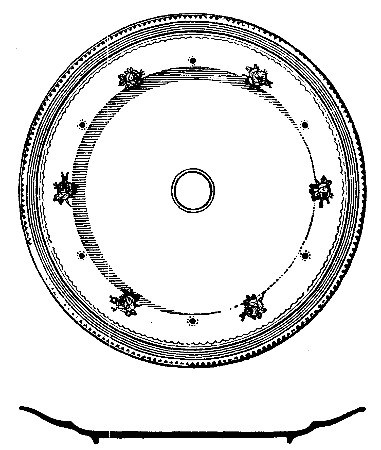
Fig. 1
9. I have here in my hand one of the simplest possible examples of the union of the graphic and constructive powers,—one of my breakfast plates. Since all the finely architectural arts, we said, began in the shaping of the cup and the platter, we will begin, ourselves, with the platter.
Why has it been made round? For two structural reasons: first, that the greatest holding surface may be gathered into the smallest space; and secondly, that in being pushed past other things on the table, it may come into least contact with them.
Next, why has it a rim? For two other structural reasons: first, that it is convenient to put salt or mustard upon; but secondly, and chiefly, that the plate may be easily laid hold of. The rim is the simplest form of continuous handle.
Farther, to keep it from soiling the cloth, it will be wise to put this ridge beneath, round the bottom; for as the rim is the simplest possible form of continuous handle, so this is the simplest form of continuous leg. And we get the section given beneath the figure for the essential one of a rightly made platter.
10. Thus far our art has been strictly utilitarian, having respect to conditions of collision, of carriage, and of support. But now, on the surface of our piece of pottery, here are various bands and spots of color which are presumably set there to make it pleasanter to the eye. Six of the spots, seen closely, you discover are intended to represent flowers. These then have as distinctly a graphic purpose as the other properties of the plate have an architectural one, and the first critical question we have to ask about them is, whether they are like roses or not. I will anticipate what I have to say in subsequent Lectures so far as to assure you that, if they are to be like roses at all, the liker they can be, the better. Do not suppose, as many people will tell you, that because this is a common manufactured article, your roses on it are the better for being ill-painted, or half-painted. If they had been painted by the same hand that did this peach, the plate would have been all the better for it; but, as it chanced, there was no hand such as William Hunt's to paint them, and their graphic power is not distinguished. In any case, however, that graphic power must have been subordinate to their effect as pink spots, while the band of green-blue round the plate's edge, and the spots of gold, pretend to no graphic power at all, but are meaningless spaces of color or metal. Still less have they any mechanical office: they add nowise to the serviceableness of the plate; and their agreeableness, if they possess any, depends, therefore, neither on any imitative, nor any structural, character; but on some inherent pleasantness in themselves, either of mere colors to the eye, (as of taste to the tongue,) or in the placing of those colors in relations which obey some mental principle of order, or physical principle of harmony.
11. These abstract relations and inherent pleasantnesses, whether in space, number, or time, and whether of colors or sounds, form what we may properly term the musical or harmonic element in every art; and the study of them is an entirely separate science. It is the branch of art-philosophy to which the word 'æsthetics' should be strictly limited, being the inquiry into the nature of things that in themselves are pleasant to the human senses or instincts, though they represent nothing, and serve for nothing, their only service being their pleasantness. Thus it is the province of æsthetics to tell you, (if you did not know it before,) that the taste and color of a peach are pleasant, and to ascertain, if it be ascertainable, (and you have any curiosity to know,) why they are so.
12. The information would, I presume, to most of you, be gratuitous. If it were not, and you chanced to be in a sick state of body in which you disliked peaches, it would be, for the time, to you false information, and, so far as it was true of other people, to you useless. Nearly the whole study of æsthetics is in like manner either gratuitous or useless. Either you like the right things without being recommended to do so, or, if you dislike them, your mind cannot be changed by lectures on the laws of taste. You recollect the story of Thackeray, provoked, as he was helping himself to strawberries, by a young coxcomb's telling him that "he never took fruit or sweets." "That," replied, or is said to have replied, Thackeray, "is because you are a sot, and a glutton." And the whole science of æsthetics is, in the depth of it, expressed by one passage of Goethe's in the end of the second part of Faust;—the notable one that follows the song of the Lemures, when the angels enter to dispute with the fiends for the soul of Faust. They enter singing—"Pardon to sinners and life to the dust." Mephistopheles hears them first, and exclaims to his troop, "Discord I hear, and filthy jingling"—"Mis-töne höre ich: garstiges Geklimper." This, you see, is the extreme of bad taste in music. Presently the angelic host begin strewing roses, which discomfits the diabolic crowd altogether. Mephistopheles in vain calls to them—"What do you duck and shrink for—is that proper hellish behavior? Stand fast, and let them strew"—"Was duckt und zuckt ihr; ist das Hellen-brauch? So haltet stand, und lasst sie streuen." There you have also, the extreme, of bad taste in sight and smell. And in the whole passage is a brief embodiment for you of the ultimate fact that all æsthetics depend on the health of soul and body, and the proper exercise of both, not only through years, but generations. Only by harmony of both collateral and successive lives can the great doctrine of the Muses be received which enables men "χαιρειν ορθως,"—"to have pleasure rightly;" and there is no other definition of the beautiful, nor of any subject of delight to the æsthetic faculty, than that it is what one noble spirit has created, seen and felt by another of similar or equal nobility. So much as there is in you of ox, or of swine, perceives no beauty, and creates none: what is human in you, in exact proportion to the perfectness of its humanity, can create it, and receive.




